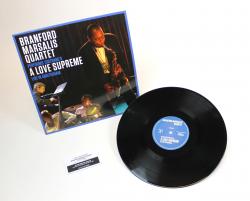 Coltrane’s A Love Supreme: Live in Amsterdam reissue from the Branford Marsalis Quartet out now and available on vinyl for the very first time Read more »
Coltrane’s A Love Supreme: Live in Amsterdam reissue from the Branford Marsalis Quartet out now and available on vinyl for the very first time Read more »
Branford Marsalis engages in classical, jazz with the CSO
Publication: Cincinnati.com
Author: Janelle Gelfand
Date: December 1, 2012
The symphony went hip Friday night.
That’s not hard to do when you have one of the finest jazz musicians in the country performing with you.
Saxophonist Branford Marsalis, a three-time Grammy-winner, NEA Jazz Master, and former “Tonight Show” bandleader, was soloist in the American premiere of a concerto for alto saxophone with the Cincinnati Symphony Orchestra. But he took it a step further, sitting in with the orchestra to play the saxophone solos in Prokofiev’s “Lieutenant Kije” Suite, which opened the evening.
Even though Marsalis easily crossed over into classical, it was no surprise that he seemed to be having the most fun in his encore, Charlie Parker’s bebop “Au Privave,” with CSO musicians Matt Zory, Jr., on bass and Marc Wolfley on drums. It was a treat to hear his upbeat improv, and the trio communicated like they had always played together.
On the podium, Quebec native Jacques Lacombe led the engaging program, ending with two extraordinary but rarely played works by Samuel Barber: “Night Flight” and Symphony No. 1.
Dutch composer Jacob Ter Veldhuis took his inspiration for his 2002 “Tallahatchie” Concerto for alto sax and chamber orchestra from the Native American word that means “river of rocks” — not from the famous county in Mississippi. The well-constructed piece draws from worlds of pop, jazz and minimalism.
Marsalis soared through the demanding score, which included staccato leaps, flourishes and glissandos that took him from the top to the basement of his instrument. The two-part piece opened with a rhapsodic slow movement, an ideal vehicle for the saxophonist’s mellow tone and knack for spinning a beautiful line.
He’s an elegant player who is not showy, but he has the technical prowess to nail the most treacherous passages. An electric cadenza for the soloist led to the fast finale. It was also fun to watch Marsalis’ rhythmic dialogue with the percussion section, as well as a few moments of what he described as “funk.”
Marsalis’ two Music Hall performances (Friday and Saturday) capped a week of local appearances as a creative director for the orchestra, which included working with jazz students at Northern Kentucky University and playing an impromptu set in the lobby of the Westin Hotel.
The evening opened with Prokofiev’s popular suite extracted from his score to the 1933 movie, “Lieutenant Kije.” Marsalis, sitting in the woodwind section, played Kije’s theme on tenor sax with a touch of swagger. Fine contributions from orchestral soloists included Robert Sullivan’s offstage cornet fanfares.
Under Lacombe, who is music director of the New Jersey Symphony, it was a crisp but uninspired reading of this charming work. The Barber pieces in the second half, though, made an impression.
“Night Flight,” given its first CSO performance, is the slow movement from Barber’s Second Symphony, which the composer wrote after serving in the U.S. Air Force during World War II. It evokes the loneliness of night missions. The string sound was plush and refined, and Christopher Philpotts played its bleak solo for English horn with singular beauty.
Barber’s Symphony No. 1, not performed by the CSO since 1969, is a remarkable work that ranks with other fine mid-century American symphonies. Lacombe was an animated leader who caught the sweep of the single-movement work, and imaginatively brought out details of its many moods. The strings projected a glorious sound in its its cinematic climaxes, and William Winstead’s bassoon provided humor in a scherzo section for winds.
Categories
Tags in Tags
Branford Marsalis Branford Marsalis Quartet ellis marsalis four mfs playin' tunes Joey Calderazzo Justin Faulkner Marsalis Family marsalis music metamorphosen miguel zenon music redeems new orleansFilter by Artist
Marsalis Music Radio
Join Our Mailing List
- RT @bmarsalis: Compliments of the @T_Blanchard archives. https://t.co/4RsXbyEloa — 3 years 9 weeks ago MarsalisMusic